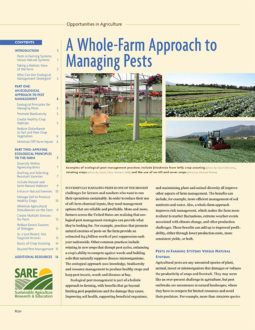What makes a healthy crop?
Healthy soil is the foundation of a healthy crop. Good tilth, drainage, water-holding capacity, high organic matter and fertility all provide a crop with the resources it needs to grow vigorously and respond to stresses from insects, diseases, weeds and harsh weather. Soil management practices such as crop rotation, cover crops, reduced tillage and application of organic materials contribute to cropping environments that are favorable for crop growth but unfavorable for pests.
What natural defenses do crop plants use?
The natural defenses that plants use to minimize stress from insects, weeds and disease-causing pathogens are widespread and can take many forms. They also reduce the impacts of harsh conditions like droughts and floods. Some examples:
- Many types of plants produce physical barriers such as waxy coatings, thorns or plant hairs to stop herbivores from feeding, to reduce disease infection and to slow water loss during extremely hot conditions. Leafhopper-resistant varieties of alfalfa, for example, depend on plant hairs to stop their major pest, the potato leafhopper.
- Most plants produce chemical defenses in response to leaf damage. Some are toxic to insects and some have antimicrobial properties that degrade disease-causing pathogens. For example, cucurbits produce a bitter-tasting chemical called cucurbitacin that is toxic to insects and deters them from feeding. Brassica and mustard plants are known to produce chemicals that are toxic to nematodes. When incorporated into the soil, mustard crop residues release these toxic chemicals into the soil to suppress nematode pests such as root-knot nematodes.
- Plants can defend themselves by relying on beneficial organisms. When under attack by herbivores, plants release chemical signals to attract predators and parasites to defend them. For example, when attacked by aphid pests, tomatoes produce chemical signals that attract parasitic wasps, which then prey on the aphids. Plant roots often form beneficial relationships with soil fungi called arbuscular mycorrhizal fungi. In exchange for sugars from the plant, mycorrhizal fungi help the plant by expanding its root system and allowing it to access nutrients deeper in the soil. There is evidence that these colonized plants may be more resistant to infection from disease-causing pathogens.
When a plant is under stress, it must divert nutritional resources from growth to defense. A cropping system that emphasizes soil health and fertility provides plants with the resources they need to defend themselves while maintaining growth.
What causes stress and how do pests exploit this?
Stress reduces crop productivity and is caused by environmental conditions like poor soils, flooding, drought and other living organisms such as insects, weeds and disease-causing pathogens. Poor, compacted soils, for example, stunt root growth and reduce the crop’s ability to take up water and to scavenge deeper into soil for important nutrients. Crop defenses are weakened under stressful conditions, and the impacts of pests on crop plants may be amplified. When crops are stressed, weeds can more aggressively compete for water, sunlight, space and nutrients, and they are capable of hosting crop diseases. Insect pests defoliate plants and can transmit disease-causing pathogens when they eat the crop. Disease-causing pathogens can more easily infect stressed plants, which have impaired defenses under stressful conditions.
Good agricultural practices should focus on reducing stress to the crop and making the environment less favorable for pests.
